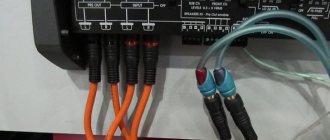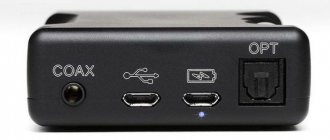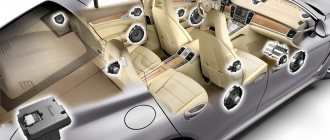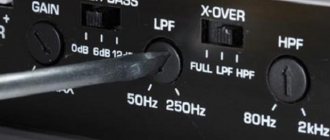The capabilities of standard radios are quite limited. Therefore, to obtain high-quality sound, it is necessary to supplement the acoustics with a car amplifier. After installing it, instruments that were previously unheard or sounded vague will appear in already familiar tracks.
To know which sound amplifier is best to buy for your car, you don’t have to be well versed in radio technology. The main thing is to take into account several basic selection criteria, which are described below. And to make the choice as simple as possible, we have compiled a rating of the best car audio amplifiers of 2022.
Criteria for choosing an amplifier in a car
When choosing an amplifier for a car, you should consider the following criteria:
- Amplifier class. There are many classes: A, B, C, D, AB. Among them, AB and D are the most common. The former produce good sound, but have low efficiency (up to 65%). Because of this, they get hot during operation, since approximately 50% of the power consumed is released as heat. In addition, these devices are large.
Class D models provide more powerful but less clear sound. They are compact, do not heat up very much (sometimes they do not heat up at all). Typically, such devices are used to connect subwoofers. The disadvantage of this class is its higher cost compared to AB.
- Number of channels. Essentially, the number of channels is the number of speaker outputs.
Amplifiers with one channel (monoblocks) are often used to connect subwoofers. They are compact and have high power. The monoblock must have an LF (low frequency) filter, which will remove the “extra bottom”. When connecting powerful subwoofers, it is advisable that the device have an ultra-low-pass filter. It cuts out sounds that are not audible to humans, but that are harmful to hearing and electronics, with a frequency of less than 20 Hz.
Two-channel amplifiers are a universal option. Suitable for connecting two speakers or one subwoofer. Three-channel ones are rare, designed for 2 speakers and 1 subwoofer. Four-channel amplifiers are used to build the entire audio system in the car. Five-channel allows you to connect 4 speakers and a subwoofer.
You can find six-channel and even eight-channel amplifiers on sale, but the demand for them is small. Such models are needed to work with multi-component audio systems.
- Power. The main criterion when choosing an amp. Power can be rated or maximum. Rated power is the power at which the amplifier is capable of operating for a long time. Peak is the one that the device is capable of providing for a limited time.
It is better not to consider the power that the manufacturer writes on the box or body of the device. Often this is either maximum power, or a completely fictitious indicator. The exact data is indicated in the documentation and product characteristics.
- Frequency range. The standard range is between 20-20000 Hz. This indicator should be taken into account when choosing. There are also models with a wider range, for example, 10-40000 Hz. This indicates that in the frequency range we hear there is a flat frequency response (amplitude-frequency response). For subwoofer amplifiers, the upper limit of the range is reduced to 250-300 Hz. This is an adequate indicator, since the sub does not need to reproduce mid and high frequencies.
- Amplifier sensitivity. Input signal parameter at which the amplifier can operate at rated power. Advanced car amplifiers are equipped with the ability to adjust sensitivity, which makes the device universal.
- Distortion factor. High levels of distortion result in reduced sound clarity. The sound becomes dull and quiet, which is very noticeable in the upper frequencies. For high-quality sound, it is enough that the coefficient is no higher than 1%. In Hi-Fi amplifiers the parameter is approximately 0.5-0.6%. And in Hi-End devices it is even lower.
- Signal to noise ratio. This is the noise level introduced by the amplifier. The higher the better. In inexpensive amplifiers, the signal-to-noise ratio ranges from 75 dB, in more advanced models – from 95-100 dB.
What's wrong with the standard amplifier?
I think it would be wrong to skip this question. There are several reasons to change the standard amplifier.
Firstly, power output. In this case, it is not needed at all for volume, or, strictly speaking, not only for it. In standard systems, very simple amplifiers and speakers with low impedance are most often used. If we are going to build a new system, then it is not at all a fact that the new speakers from the standard amplifier will sound good. They may have, for example, higher impedance, lower sensitivity, and with them we are likely to get God knows what. The exception is acoustics, which were initially positioned by manufacturers for a stock upgrade, but we seem to have set our sights on more serious improvements, and have already left this option behind.
Standard audio systems are mainly made not by car manufacturers themselves, but by third-party companies on order from car manufacturers. But not everyone puts their nameplate on the front panel
Secondly, because the systems are developed to meet fairly stringent requirements - both price and design. If you openly announce that, say, audio components for Honda are made by Pioneer and Alpine, this could damage the reputation of these brands.
Thirdly, equipment. The stock amplifier is designed for one single system option and has zero point tens in terms of additional settings. What if we just need to turn on the high-pass filter in the front or rear channels? What if you need to adjust the low-pass filter in the subwoofer channels in order to connect it with speaker systems? What if there are more serious intentions?
So, it turns out that when upgrading a system, simply replacing acoustics does not always work, and a new amplifier becomes a must-have.
Where to start looking for the right amplifier?
As always, the choice should be made based on needs. In other words, we first design the composition of the system, and from it it becomes clear what the amplifier should be like. The simplest thing is to take a piece of paper and draw where the speakers will be installed.
Decide on the type of acoustics connection - through passive crossovers or channel-by-channel with active band division. Both options have their advantages and disadvantages, but this is a topic for another discussion. For now, I’ll just note that the first option is simpler, and the second has more options for customizing and “mixing” the bands. Depending on the chosen option, we will select amplifiers with the required number of channels and functionality.
The audio system can be quite complex. Active division channel amplification and processors are common for high-end automotive systems
Already at this stage, evaluate what will be the source in the system. If the head unit has regular linear outputs, then there are no problems. If you are dealing with a standard “head”, then you almost always have to look for workarounds. I have already discussed this topic in more detail in the article “Sound in a car: how to make a standard system sound better”; now I will only note what concerns connecting amplifiers.
So, there are several options. The simplest one is to connect directly to the outputs of a standard amplifier. To do this, the new amplifier must have high-level inputs in addition to regular inputs. If they are not available, then you can use so-called “high-level to linear converters.”
High-level inputs are included in many car amplifier models
This option is simple, but not always applicable. Most often, a standard amplifier produces, at best, a corrected signal, and at worst, you have to deal with multi-band amplification altogether. In this case, you can “collect” the original signal only with a specialized processor, and only then connect an amplifier to it. This also includes options for standard systems with a MOST bus, from which an SPDIF or analog signal can be “pulled” with a special adapter.
As such complex systems become more and more common, it is not at all surprising that amplifiers with an already built-in processor have begun to appear on the market. But about the equipment a little further.
How much does an amplifier cost for a car?
The most popular amplifiers are in the price range from $50 to $600 . This rating includes representatives of all price segments. Among the Chinese nameless crafts, you can find cheaper options, but they are usually not worth attention (either unreliable or do not provide high-quality sound).
It’s worth remembering right away that a high-quality amplifier cannot be particularly cheap. But not all expensive models provide really excellent sound. In this area, such disproportionality is clearly visible.
Budget models range from $50 to $100. There are proven models in this segment. Basically, at these prices it makes sense to look at monoblocks for a subwoofer. But there are also interesting multi-channel models. Best of all, class AB. Cheap multi-channel Class D amplifiers are very suspicious devices.
From $100 to $200-250 you can choose an average quality model of any type and class. Most music lovers buy just such amplifiers in their cars.
Models can be called expensive, with prices in the region of $400-600 . Although options for $250-400 cannot be called cheap.










